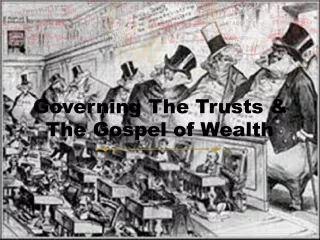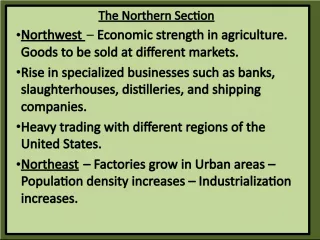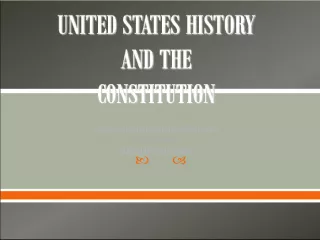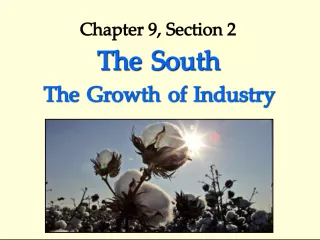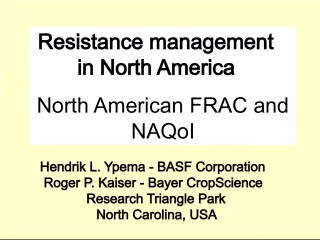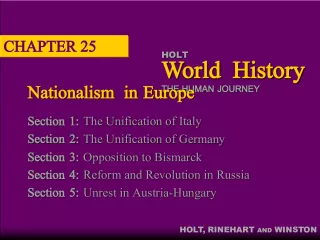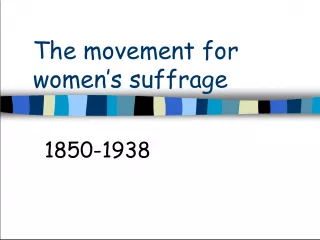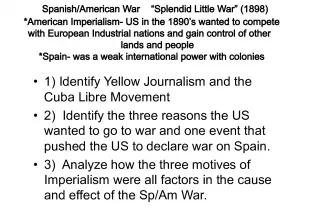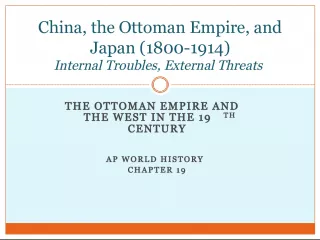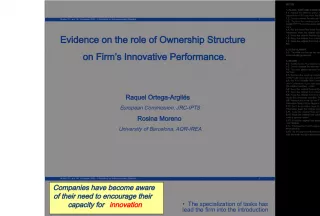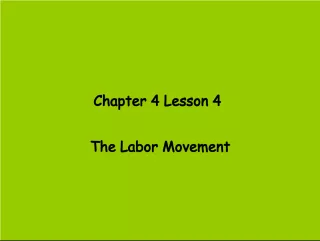Industrialization and Growth of Industry in Late 19th Century America
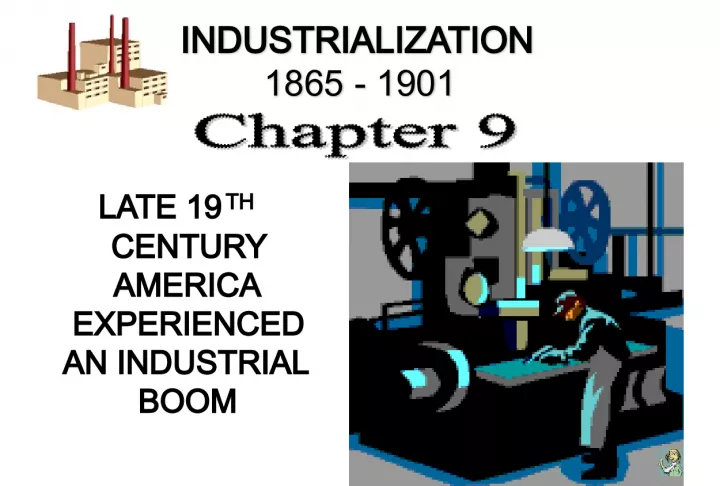

This article discusses the period of industrialization in America from 1865 to 1901 and how it led to a significant growth in the nation's industry. From the Civil War to the early 1900s, America emerged as the world's leading industrial nation, and this article explains how this happened.
- Uploaded on | 9 Views
-
 joao
joao
About Industrialization and Growth of Industry in Late 19th Century America
PowerPoint presentation about 'Industrialization and Growth of Industry in Late 19th Century America'. This presentation describes the topic on This article discusses the period of industrialization in America from 1865 to 1901 and how it led to a significant growth in the nation's industry. From the Civil War to the early 1900s, America emerged as the world's leading industrial nation, and this article explains how this happened.. The key topics included in this slideshow are Industrialization, Gross National Product, Trade Union, Laissez-faire, Entrepreneur, Monopoly, Trust, Fixed cost, Economies of scale, Time Zone,. Download this presentation absolutely free.
Presentation Transcript
1. INDUSTRIALIZATION 1865 - 1901 INDUSTRIALIZATION 1865 - 1901 LATE 19 TH CENTURY AMERICA EXPERIENCED AN INDUSTRIAL BOOM
2. Gross National Product trade union Laissez-faire industrial union Entrepreneur lockout corporation Marxism pool arbitration vertical integration holding company horizontal integration closed shop Monopoly deflation Trust Fixed cost Economies of scale operating costs Land grant Time Zone
3. Even though the Industrial Revolution began in the USA in the early 1800s, our nation was still largely a rural farming country when the Civil War started in 1860. Even though the Industrial Revolution began in the USA in the early 1800s, our nation was still largely a rural farming country when the Civil War started in 1860. Out of a population of more than 30 million, only about 1.3 million Americans worked in industry in 1860. Out of a population of more than 30 million, only about 1.3 million Americans worked in industry in 1860. After the Civil war (won by the North) industry grew rapidly and expanded. Consequently, millions of Americans left their farms to work in mines and factories. (factories in Cities) After the Civil war (won by the North) industry grew rapidly and expanded. Consequently, millions of Americans left their farms to work in mines and factories. (factories in Cities) By the early 1900s , the USA became the worlds leading industrial nation and by 1914 our gross national product (GNP) the total value of all goods and services produced by a country was eight times greater than it had been when the Civil War ended in 1865. By the early 1900s , the USA became the worlds leading industrial nation and by 1914 our gross national product (GNP) the total value of all goods and services produced by a country was eight times greater than it had been when the Civil War ended in 1865.
4. THE EXPANSION OF INDUSTRY This enormous growth was due to three factors ; 1) Natural Resources 2) Governmental support 3) Urbanization
5. BLACK GOLD In 1859 , Edwin Drake used a steam engine to drill for oil This breakthrough started an oil boom in the Midwest and later Texas Spindle TOP throwing out the gasoline At first the process was limited to transforming the oil into kerosene and throwing out the gasoline -- a by-product of the process Later, the gasoline was used for cars EDWIN DRAKE PICTURED WITH BARRELS OF OIL
6. BESSEMER STEEL PROCESS The Bessemer process (Henry Bessemer & William Kelly) Oil was not the only valuable natural resource Coal and iron were plentiful within the U.S. When you removed the carbon from iron , the result was a lighter, more flexible and rust resistant compound Steel BESSEMER CONVERTOR CIRCA 1880
7. NEW USES FOR STEEL The railroads, with thousands of miles of track, were the biggest customers for steel skyscrapers Other uses emerged: barbed wire , farm equipment, bridge construction (Brooklyn Bridge- 1883),and the first skyscrapers BROOKLYN BRIDGE SPANS 1595 FEET IN NYC
8. Causes of Industrialization Causes of Industrialization National Resources (Raw Materials) Water, timber, coal, iron, copper Consumer Needs helped settle the West RR expanded during this time Oil (petroleum) turned into . . . Kerosene lanterns & stoves Edwin Drake 1 st oil 1859 - Edwin Drake 1 st oil well, Titusville, Pa. Population Increase Large workforce tripled 1860 1910, USA tripled due to immigration & large families Free Enterprise Laissez faire Entrepreneurs
9. Causes of Industrialization Causes of Industrialization Free Enterprise Laissez faire Entrepreneurs The USA practiced laissez-faire economics in the late 1800s . The USA practiced laissez-faire economics in the late 1800s . State and federal governments kept taxes and spending low and did not impose costly regulations on industry. The GOVT. did not try to control wages and prices. State and federal governments kept taxes and spending low and did not impose costly regulations on industry. The GOVT. did not try to control wages and prices.
10. Civil War Struggles Civil War Struggles North , high tariffs to protect American industry from foreign competition North , high tariffs to protect American industry from foreign competition Federal subsidies (free money) for roads, RR, & canals to the West Federal subsidies (free money) for roads, RR, & canals to the West South , low tariffs to promote trade (cotton) with Europe . . . . Texas was the largest cotton producing state at that time South , low tariffs to promote trade (cotton) with Europe . . . . Texas was the largest cotton producing state at that time Morrill Tariff voted in when the SOUTH seceded Republicans in Control of Congress.. Tripled taxes on imports, gave away western land for RR Morrill Tariff voted in when the SOUTH seceded Republicans in Control of Congress.. Tripled taxes on imports, gave away western land for RR Free Trade - be able to compete internationally Free Trade - be able to compete internationally
11. 1876- Thomas Alva Edison established the worlds first research lab in New Jersey There Edison perfected the incandescent light bulb in 1880 Later he invented an entire system for producing and distributing electricity By 1890 , electricity powered numerous machines EDISON
12. Another important invention of the late 19 th century was the telephone Alexander Graham Bell and Thomas Watson unveiled their invention in 1876 BELL AND HIS PHONE
13. New Inventions New Inventions Alexander Graham Bell Alexander Graham Bell 1876, Telephone (AT&T) 1876, Telephone (AT&T) Thomas Alva Edison Thomas Alva Edison 1877, Phonograph 1877, Phonograph 1879, Light Bulb 1879, Light Bulb 1889, Edison General Electric Company (GE) 1889, Edison General Electric Company (GE) Textile Industry Textile Industry Northrup Automatic Loom (clothes made faster) Northrup Automatic Loom (clothes made faster) Standard Sizing (ready made clothing) Standard Sizing (ready made clothing) Power-driven Sewing Machine Power-driven Sewing Machine Mass production of Shoes Mass production of Shoes
15. Railroads Railroads Linking the Nation Linking the Nation 1865, 35,000 miles 1865, 35,000 miles 1900, 200,000 miles 1900, 200,000 miles Transcontinental Railroad Transcontinental Railroad 1862, Pres. Lincoln, Pacific Railway Act 1862, Pres. Lincoln, Pacific Railway Act Union Pacific Irish immigrants Union Pacific Irish immigrants Central Pacific Chinese immigrants labor shortage in California Central Pacific Chinese immigrants labor shortage in California
16. Railroads cont. Railroads cont. Spurring Growth Spurring Growth Increased markets & desire for raw materials Increased markets & desire for raw materials Consolidation of smaller lines (Vanderbilt) Consolidation of smaller lines (Vanderbilt) Allowed cars to be shifted from one section of the country to another based on seasonal needs . Allowed cars to be shifted from one section of the country to another based on seasonal needs . American Railway Association - 1883 American Railway Association - 1883 Time Zones, safer more reliable Time Zones, safer more reliable Air Brakes, pull longer, heavier trains Air Brakes, pull longer, heavier trains Standard Gauge, unite all lines Standard Gauge, unite all lines Land Grant System - National Govt. helps finance the construction of a National Railroad System. Land Grant System - National Govt. helps finance the construction of a National Railroad System. Gave RR companies land in the unsettled West Gave RR companies land in the unsettled West Sold land for $$ to finance rail construction Sold land for $$ to finance rail construction
17. Refrigerated Railroad Car ship meat made it possible to ship meat from slaughterhouses to cities from slaughterhouses to cities Railroads cont. Railroads cont.
18. RAILROAD AND TIME Before 1883 , each community still operated on its own time For example: Noon in Boston was 12 minutes later than noon in New York City Indiana had dozens of different times No standard time reference
19. PROFESSOR DOWD CREATES TIME ZONES In 1869, to remedy this problem, Professor C.F. Dowd proposed dividing the earth into 24 time zones The U.S. would be divided into 4 zones : the eastern, Central, Mountain, and Pacific 1883 Railroads synchronized their watches across U.S. 1884 International Conference adopts zones PROFESSOR DOWD EXPLAINS HIS TIME ZONES
20. The corruption in the railroad industry became public in 1872 when the credit Mobilier scandal erupted. CREDIT MOBILIER set up by several stockholders of the Union Pacific RR CREDIT MOBILIER was a construction company set up by several stockholders of the Union Pacific RR , including Oakes Ames, a member of Congress. Credit Mobilier (the construction company) overcharged Union Pacific for the work it did Acting for both the Union Pacific and Credit Mobilier, the investors signed contracts with themselves . Consequently, Credit Mobilier (the construction company) overcharged Union Pacific for the work it did , and since the same investors controlled both companies, the railroad agreed to pay the huge bills, because in effect --- THEY WERE PAYING THEMESELVES.
21. The great wealth many railroad ENTREPRENEURS acquired in the late 1800s led to accusations that they had built their fortunes by swindling investors and taxpayers, bribing government officials , and cheating on their contracts and debts. The great wealth many railroad ENTREPRENEURS acquired in the late 1800s led to accusations that they had built their fortunes by swindling investors and taxpayers, bribing government officials , and cheating on their contracts and debts. The person with probably the worst REPUTATION for this kind of activity was JAY Gould , whom often practiced insider trading The person with probably the worst REPUTATION for this kind of activity was JAY Gould , whom often practiced insider trading He used information he received as a railroad owner to manipulate stock prices to his financial benefit. He used information he received as a railroad owner to manipulate stock prices to his financial benefit. Robber Barons Characterized as Robber Barons RR Entrepreneurs-owners Built fortunes by swindling taxpayers, bribing govt. officials, & cheating on contracts
22. ROBBER BARONS Famous Robber Barons included Carnegie, Rockefeller, Vanderbilt, Stanford, and J.P. Morgan J.P MORGAN IN PHOTO AND CARTOON
24. THE GRANGE AND THE RAILROADS Farmers were especially affected by corruption in the railroad industry Grangers (a farmers organization) protested land deals, price fixing, and charging different rates to different customers Granger Laws were then passed protecting farmers States were given regulation control of railroads by the Courts GRANGERS PUT A STOP TO RAILROAD CORRUPTION
25. Were the founders of American industry "robber barons" or "captains of industry?" The wave of industrialism that we have been studying was often driven by a few great men known as industrialists. There can be no mistaking their motives: wealth. There is some debate, however, on the how history should portray these industrialists. Some feel that the powerful industrialists of the gilded age should be referred to as "r obber barons. " This view accentuates the negative. It portrays men like Vanderbilt and Rockefeller and Ford and cruel and ruthless businessmen who would stop at nothing to achieve great wealth. These "robber barons" were accused of exploiting workers and forcing horrible working conditions and unfair labor practices upon the laborer. Another view of the industrialist is that of "captain of industry. " The term captain views these men as viewed ingenious and industrious leaders who transformed the American economy with their business skills. They were praised for their skills as well as for their philanthropy (charity). In reality the debate over robber barons and captains of industry mirrors views of industrialism itself. Just as their were both positives and negatives to industrialism there were positives and negatives to the leaders of industrialism
26. ` Industrialization Railroads Vanderbuilt Steel Carnegie Oil Rockefeller Banking Morgan Technology Edison Unions Gompers Andrew Carnegie John D. Rockefeller Samuel Gompers Cornelius Vanderbilt Thomas Edison J. P. Morgan
27. Big Business Corporation Produces more goods cheaper Continue to operate in poor economic times Can negotiate rebates from RR lowers operating costs Drives out smaller competitors Economies of Scale - Economies of Scale large corporations to produce goods cheaper & quicker than small manufacturers could Pools Companies agree to maintain prices of certain products
28. CARNEGIES VERTICAL INTEGRATION Carnegie attempted to control as much of the steel industry as possible How? Vertical integration; he bought out his suppliers (coal fields, iron mines, ore freighters, and rail lines) in order to control materials and transportation
29. HORIZONTAL INTEGRATION Additionally, Carnegie bought up the competition through friendly and hostile takeovers This is known as Horizontal Integration; buying companies that produce similar products in this case other steel companies MERGERS
31. Business Practices Business Practices Monopoly Monopoly Single company achieves control of an entire market Single company achieves control of an entire market Many states begin outlawing Many states begin outlawing Trusts Trusts Legal maneuver allowing trustee to manage another persons property (trustee) Legal maneuver allowing trustee to manage another persons property (trustee) Holding Companies Holding Companies Produce no product Produce no product Controls stock several companies, merging into one large enterprise Controls stock several companies, merging into one large enterprise
32. BUSINESS GROWTH & CONSOLIDATION Mergers could result in a monopoly (Trust) An example of consolidation : In 1870 , Rockefeller Standard Oil Company owned 2% of the countrys crude oil By 1880 controlled 90% of U.S. crude oil CHICAGOS STANDARD OIL BUILDING IS ONE OF THE WORLDS TALLEST
33. SHERMAN ANTI-TRUST ACT In 1890, the Sherman Anti- Trust Act made it illegal to form a monopoly (Trust) Prosecuting companies under the Act was not easy a business would simply reorganize into single companies to avoid prosecution Seven of eight cases brought before the Supreme Court were thrown out
34. Advertising New ways to market 1900 - $90 million in ads Department Stores Shopping becomes a past time (fun) Everything under one roof (Macys) Chain Stores Group of similar stores owned by same company Lower prices instead of elaborate service (Woolworths) Mail Order (Sears) Catalogue buying (Sears)
35. Working in the U.S. Workers Machines replacing skilled labor Working conditions were unhealthy & dangerousbreathing in dust and Working conditions were unhealthy & dangerousbreathing in dust and toxic fumes toxic fumes $.22 per hour, 59 hours per week Skilled craft workers higher wages Laborers few skills, lower wages To improve conditions organize into Unions
36. WORKERS HAD POOR CONDITIONS no compensation for injuries Workers routinely worked 6 or 7 days a week, had no vacations, no sick leave, and no compensation for injuries Injuries were common Injuries were common In 1882 , an average of 675 workers were killed PER WEEK on the job
37. Early Unions Trade Unions Limited to workers with skills Industrial Unions United craft workers & common laborers in a particular industry Anti-Union Methods Contracts to not join a union Blacklist not hire suspected Union organizers Lockout locked workers out & refused to pay them Strikebreakers replace workers during strikes (Scab)
38. Union Problems Union Problems No laws protecting the right to organize No laws protecting the right to organize Courts ruled strikes were conspiracies that interfered with trade Courts ruled strikes were conspiracies that interfered with trade Perception that unions threatened American Institutions (Nativism) Perception that unions threatened American Institutions (Nativism) Marxist, Anarchists, or Revolutionaries Marxist, Anarchists, or Revolutionaries Rarely successful Rarely successful
39. STRIKES TURN VIOLENT Several strikes turned deadly in the late 19 th century as workers and owners clashed The Great Strike of 1877: Workers for the Baltimore and Ohio Railroad struck to protest wage cuts
40. The Great Railroad Strike of 1877 The Great Railroad Strike of 1877 Cut wages Cut wages Nations 1 st labor protest Nations 1 st labor protest 80,000 workers, 11 states 80,000 workers, 11 states President Hayes sends troops to regain order President Hayes sends troops to regain order 100 killed, millions in damages 100 killed, millions in damages Failure led to organization of Knights of Labor Failure led to organization of Knights of Labor
41. Knights of Labor Knights of Labor 1 st nationwide industrial union 1 st nationwide industrial union 8 hr. work day 8 hr. work day Govt. bureau of labor stats Govt. bureau of labor stats Equal pay for women Equal pay for women Abolition of child labor Abolition of child labor Creation of worker owned factories Creation of worker owned factories Use of arbitration 3 rd party negotiators Use of arbitration 3 rd party negotiators -membership 100,00 to 700,000 in 1886 -membership 100,00 to 700,000 in 1886 The Great Railroad Strike of 1877 The Great Railroad Strike of 1877
42. Haymarket Riot of 1886 Haymarket Riot of 1886 -8 hr. day -8 hr. day Clash between police & workers one striker killed Clash between police & workers one striker killed Anarchists set off bomb in Haymarket Square police open Anarchists set off bomb in Haymarket Square police open fire fire 7 cops, 4 workers die 7 cops, 4 workers die 8 arrested, 4 executed (only 1 a Knight) 8 arrested, 4 executed (only 1 a Knight) Knights of Labor membership declines Knights of Labor membership declines
43. American Railway Union (ARU) Eugene V. Debs unionized the Pullman Palace Car Co. Cut wages (depression) Workers complained- got fired = strike ARU stopped handling Pullman cars Paralyzed U.S. economy Attached mail cars Detach Pullman cars = detach mail cars Violation of federal law, interfering with U.S. mail George Pullman
44. 1881, Samuel Gompers Politics Reject socialist/communistic ideas Fight for small gains Strike only if negotiations fail Goals Companies to recognize unions & collective bargaining Closed shops hire only union workers 8 hr. work day
45. Working Women Domestic servants, teachers, nurses, secretaries Paid less for same job Excluded from unions Womens Trade Union League (WTUL ) 8 hr. work day No evening work No child labor Minimum wage
46. A. M o v e m e n t t o t h e s u b u r b s B. F i n a n c i n g r a i l r o a d c o n s t r u c t i o n C. O v e r c r o w d e d h o u s i n g D. D e v e l o p m e n t o f c i t y p a r k s



